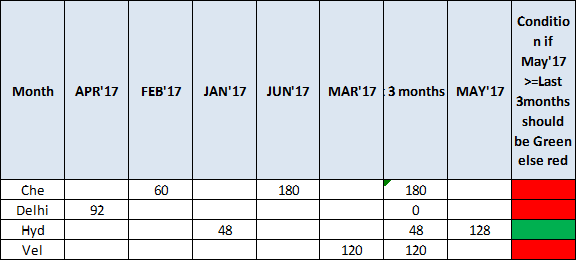Turn on suggestions
Auto-suggest helps you quickly narrow down your search results by suggesting possible matches as you type.
Showing results for
- Home
- /
- SAS Viya
- /
- Visual Analytics
- /
- How add aggregate measure and conditions in SAS VA Cross Tab
Options
- RSS Feed
- Mark Topic as New
- Mark Topic as Read
- Float this Topic for Current User
- Bookmark
- Subscribe
- Mute
- Printer Friendly Page
- Mark as New
- Bookmark
- Subscribe
- Mute
- RSS Feed
- Permalink
- Report Inappropriate Content
Posted 03-22-2017 11:25 PM
(1775 views)
Dataset:
| Month | Location | Production | Pended | Pended% |
| JAN'17 | Hyd | 12 | 3 | 20% |
| FEB'17 | Che | 15 | 2 | 12% |
| MAR'17 | Vel | 30 | 4 | 12% |
| APR'17 | Delhi | 23 | 1 | 4% |
| MAY'17 | Hyd | 32 | 2 | 6% |
| JUN'17 | che | 45 | 1 | 2% |
| JAN'17 | Hyd | 12 | 3 | 20% |
| FEB'17 | Che | 15 | 2 | 12% |
| MAR'17 | Vel | 30 | 4 | 12% |
| APR'17 | Delhi | 23 | 1 | 4% |
| MAY'17 | Hyd | 32 | 2 | 6% |
| JUN'17 | che | 45 | 1 | 2% |
| JAN'17 | Hyd | 12 | 3 | 20% |
| FEB'17 | Che | 15 | 2 | 12% |
| MAR'17 | Vel | 30 | 4 | 12% |
| APR'17 | Delhi | 23 | 1 | 4% |
| MAY'17 | Hyd | 32 | 2 | 6% |
| JUN'17 | che | 45 | 1 | 2% |
| JAN'17 | Hyd | 12 | 3 | 20% |
| FEB'17 | Che | 15 | 2 | 12% |
| MAR'17 | Vel | 30 | 4 | 12% |
| APR'17 | Delhi | 23 | 1 | 4% |
| MAY'17 | Hyd | 32 | 2 | 6% |
| JUN'17 | che | 45 | 1 | 2% |
Expected Result:
1 REPLY 1
- Mark as New
- Bookmark
- Subscribe
- Mute
- RSS Feed
- Permalink
- Report Inappropriate Content
You could create a new measure (see you if it's better a new calculated itam or a new aggregated measure) that consider the diffence between the last month and the sum of the last three month.
Applay as visualization rule this difference to the column that you wish
Applay as visualization rule this difference to the column that you wish
April 27 – 30 | Gaylord Texan | Grapevine, Texas
Registration is open
Walk in ready to learn. Walk out ready to deliver. This is the data and AI conference you can't afford to miss.
Register now and lock in 2025 pricing—just $495!
Tips for filtering data sources in SAS Visual Analytics
See how to use one filter for multiple data sources by mapping your data from SAS’ Alexandria McCall.
Find more tutorials on the SAS Users YouTube channel.


